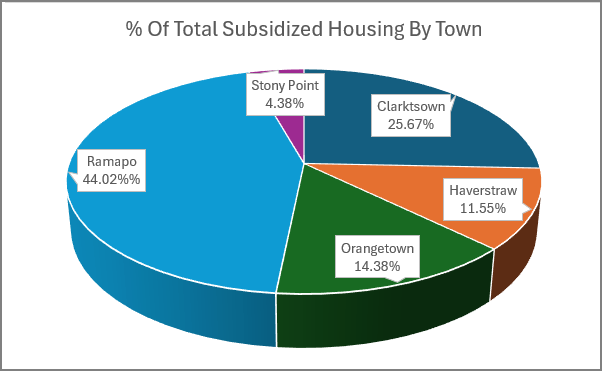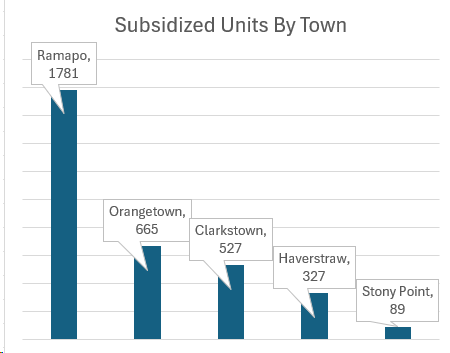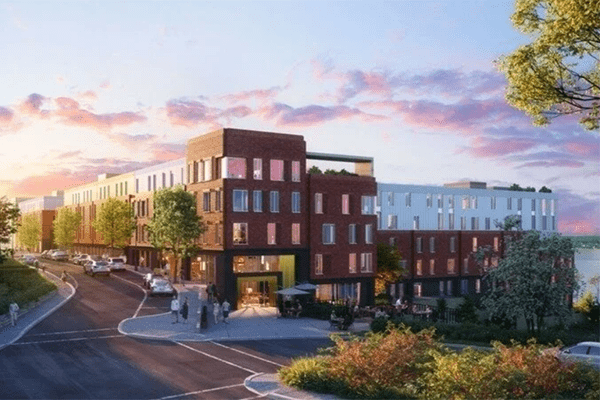|
RCBJ-Audible (Listen For Free)
|
Town of Haverstraw Ranks Fourth Out Of Five Rockland Towns In Quantity Of Subsidized Housing Units
By Tina Traster
For 23 years, a group of more than 60 human services organizations has been meeting on the first Wednesday each month at the Haverstraw Center to discuss how to help those in need. This week, the topic of conversation focused on one of the most critical deficits countywide: affordable housing.
“This is what you have identified at retreats over the last three years,” said Marion Breland, director of youth and family services for the Village of Haverstraw. “This county is facing a major issue. Housing is it.”
Breland addressed a room packed with some 40 representatives from the county’s nonprofits, school districts, libraries, and local government. She kicked off the meeting with inspirational words borrowed from great thinkers and humanitarians on the connection between home and dignity before handing over the program to Village of Haverstraw officials Mayor Mike Kohut and Trustee Richard Sena, as well as two developers who are planning affordable projects in the village. Both came to present their concepts — not only educate but to advocate because they appear to be facing a stumbling block: scoring approval from the Town of Haverstraw for needed PILOT (payment in lieu of taxes) incentives.
The developers both say they have the support of the village, school district, and county – the other taxing authorities that sign off on PILOTs.
By all accounts, the need for affordable housing in the county and especially in Haverstraw is dire.
Perhaps the most startling moment occurred when Alexandra Obremski, Rockland County Director of Community Development, said plainly what many are afraid to say out loud: “the county is hostile to affordable housing.” She said affordable housing developers have told her the regulatory process is a nightmare. Affordable housing developers are understandably going elsewhere, she said.
But the regulatory framework is not the only obstacle. The 2024 Rockland County Housing Needs Assessment, prepared by Pattern For Progress, says, “exclusionary land-use policies are a significant barrier to meeting housing needs in Rockland County.” In other words, most of the county’s housing is overwhelmingly comprised of single-family homes in single family zones.
Citing statistics from the recently issued Rockland County Housing Assessment Needs report, she said 42 percent of the town’s (Town of Haverstraw) residents are housing burdened, while 52 percent of residents in the Village of Haverstraw are spending more than 30 percent of income on housing costs.
“This leaves people without money for the emergency car repair, the Little League coach unable to coach because he has to work two jobs,” she added.
Both the Westchester-based Westhab Inc., which is planning 81 affordable housing units and the Huntington, Long Island-based MPact Collective, which has proposed about 307 rent stabilized affordable and workforce housing units at the former Chair Factory site, are concerned about the town’s lack of commitment to the PILOTs to date.
Haverstraw Town Supervisor Howard Phillips has said in private conversations, according to sources, and in public spaces, Haverstraw has done its “fair share” of building affordable housing and that other towns in Rockland need to pick up the slack.
According to the Needs Assessment report, Haverstraw has 327 affordable units, landing second to last among the five towns. Ramapo leads with 1,781, followed by 665 in Orangetown, and 527 in Clarkstown. Stony Point has the fewest, 89.


Phillips was not present at the Haverstraw Collaborative meeting.
“Howard Phillips is not here,” Breland said. “He is not feeling well. He will be at our October meeting.”
In the meantime, Ryan Porter, a principal with MPact Collective LLC, presented the nuts and bolts of the Chair Factory project, which includes 239 affordable units and 68 middle income units, as well as 150 market rate rentals on the vacant nine-acre Hudson River peninsula. The mixed-use project also calls for retail, commercial, and a hotel in the second phase.
The proposed project was seen as a much-needed and long overdue catalyst for economic revival in the village – and Kohut hoped the project would be the crown jewel of his mayoral legacy.
“It is increasingly impossible to live in the village,” he said. “Rents have skyrocketed, interest rates are high, the cost of a single-family home is not within reach for young people starting out.”
Contrasting plans for the Chair Factory development with Ginsburg’s Waterfront At Harbors luxury waterfront development, he said the latter brought new taxes, streetscaping, and infrastructure but it never achieved connectivity with the heart of the village’s downtown.
He hopes the Chair Factory will.
“We didn’t want an enclave of wealthy people who didn’t come into the village,” said Kohut, adding the proposed Chair Factory’s tiered affordable housing will tie together fallow, municipally owned and untaxed waterfront with downtown. “We believe this project will do that.”
MPact Collective will not purchase the property until the PILOT and other state and private funding is in place. The developer plans to pay nearly $8 million for the nine-acre site, as well as three to four private parcels it is in the process of acquiring.
In January, the Rockland County Industrial Development Agency (IDA) authorized a raft of benefits for the $330 million Chair Factory project, including a $1.65 million exemption from mortgage tax recording, an $18.5 million exemption from sales tax, and the approval to participate in a PILOT program.
To bring affordable housing to the village and put a municipal parking lot on the tax rolls, the village entered into a private/public partnership with WestHab Inc. for a 99-year ground lease for 30 West Street. In exchange, the developer has plans to build 81 units of affordable housing for residents earning up to 60 percent of area median income (AMI). Rents will be targeted to income tiers ranging from 30 percent to 60 percent of AMI.
Some units will be reserved for formerly homeless individuals and those with mental health disorders, addressing critical housing needs in the community.
The IDA signed off on the Westhab PILOT program last December.
According to the developer’s application, the $45 million project, which is to be designed by Suffern-based Aufgang Architects, will not displace any residents. Community parking will generate revenue for the village, while eliminating the cost of village maintenance. The project will benefit from density bonuses for green building, solar, affordable housing, and public parking, and will take advantage of reduced parking requirements for affordable housing.
The development will rely on bank financing of about $7 million, state, federal grants and tax credits of about $20 million, New York State subsidies of about $12 million, and Rockland County and other funding sources of about $6.6 million, according to public documents.
Both developers must negotiate PILOTs with the individual taxing authorities — village, town, school district and county — but the town appears to be holding out. Developers are hoping community advocacy will get the Town of Haverstraw over the finish line.
“It’s a numbers game,” said Sena. “Without a PILOT, this doesn’t happen.”
Wrapping up his presentation, Porter said, “This is a call to action,” asking attendees at the Haverstraw Collaborative meeting to send letters of support for the Chair Factory development to Town of Haverstraw officials. Porter acknowledged the town has fiduciary responsibilities, but he also said the Village-approved SEQRA (State Environmental Quality Review Act) report shows the project does not cause significant impacts.
PILOTS are often misunderstood.
PILOTs schedule payments to taxing jurisdictions over a long term. They provide certainty of revenue for the county, town, village, and school district, though the amounts are typically lower than assessments based on fair market value. The incentive is necessary to make a project financially feasible for project lenders, not to enhance the profitability to the developer.
A common misunderstanding is that PILOTs increase property taxes. In fact, the lack of development and lack of new taxpaying properties are the cause of increased taxes. Municipal salaries, insurance premiums, and maintenance and improvements on public facilities are always increasing, and without new revenue from development, the existing taxpaying base has to cover those ever-increasing costs.
PILOTs have a net-positive impact on tax rolls, as the economic benefits derived from the project outweigh the costs of the PILOT. The IDA is required to certify a positive net benefit through an economic analysis before it can authorize a PILOT. And PILOTs preclude developers from filing annual tax certiorari challenges during the term of the PILOT. If a developer does not deliver, PILOTs have a recapture provision that allows the IDA to void the PILOT agreement and enable the taxing authorities to collect the lost tax revenue and assess the property at full market value.
It remains unclear how long the developers can hold out for town approval on the PILOTs or what other workarounds they might consider.
Hopeful that things are moving in the right direction, Andrew Germansky, senior vice president of real estate at Westhab, said “We’re in the midst of negotiating for PILOT terms with the various taxing authorities. We are hopeful we can come to terms on an agreement that works for Westhab and the taxing authorities to make this 100 percent affordable housing development financeable. We need a PILOT to complete this project.”
Obremski suggested affordable housing, perhaps stigmatized by false notions, should be rebranded as “attainable” or “achievable” housing. The kind of housing, she said, that’s needed by a bus driver, an EMT, first-year teachers, county employees.
Nyack Point at 263 Main Street in Nyack, she added, is the last affordable housing built in the county. That was in 2017.
For more information about the Haverstraw Collaborative, call (845) 429-5731, or email us at Haverstraw.Collaborative@vohny.com.











